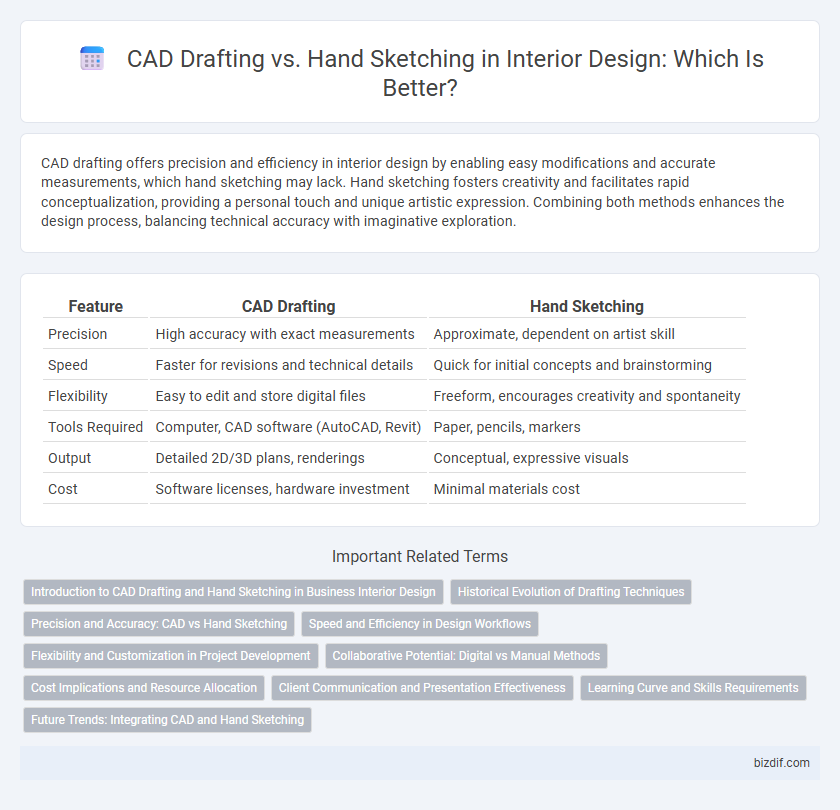CAD drafting offers precision and efficiency in interior design by enabling easy modifications and accurate measurements, which hand sketching may lack. Hand sketching fosters creativity and facilitates rapid conceptualization, providing a personal touch and unique artistic expression. Combining both methods enhances the design process, balancing technical accuracy with imaginative exploration.
Table of Comparison
| Feature | CAD Drafting | Hand Sketching |
|---|---|---|
| Precision | High accuracy with exact measurements | Approximate, dependent on artist skill |
| Speed | Faster for revisions and technical details | Quick for initial concepts and brainstorming |
| Flexibility | Easy to edit and store digital files | Freeform, encourages creativity and spontaneity |
| Tools Required | Computer, CAD software (AutoCAD, Revit) | Paper, pencils, markers |
| Output | Detailed 2D/3D plans, renderings | Conceptual, expressive visuals |
| Cost | Software licenses, hardware investment | Minimal materials cost |
Introduction to CAD Drafting and Hand Sketching in Business Interior Design
CAD drafting in business interior design provides precise, scalable, and easily modifiable digital blueprints that enhance accuracy and collaboration among design teams. Hand sketching offers a tactile and intuitive approach, allowing designers to quickly visualize concepts and explore creative ideas during initial project phases. Integrating both methods supports efficient workflow by balancing technical detail with artistic expression in commercial spaces.
Historical Evolution of Drafting Techniques
CAD drafting revolutionized interior design by digitizing and streamlining the creation of precise floor plans and 3D models, evolving from the era of hand sketching where draftsmen relied on manual tools like pencils and rulers. The transition from hand sketching to CAD allowed for enhanced accuracy, easier modifications, and efficient collaboration among design teams, reflecting significant technological advancements in design workflows. Early drafting techniques focused heavily on artistic skill and manual calculation, whereas modern CAD software integrates automation, parametric design, and real-time visualization, marking a pivotal shift in the interior design process.
Precision and Accuracy: CAD vs Hand Sketching
CAD drafting offers unparalleled precision and accuracy through digital tools that enable exact measurements and scalable designs, reducing human error significantly. Hand sketching, while expressive and flexible, lacks the consistency of CAD, often resulting in variations that can impact the final design's accuracy. Digital CAD models streamline client approvals and construction processes by providing detailed, error-free blueprints unavailable in traditional hand sketches.
Speed and Efficiency in Design Workflows
CAD drafting significantly enhances speed and efficiency in interior design workflows by enabling rapid modifications, precise measurements, and easy replication of design elements. Hand sketching, while offering creative freedom and quick conceptualization, often requires more time for revisions and lacks the automatic accuracy and scalability inherent in CAD tools. Integrating CAD software streamlines project timelines, reduces errors, and facilitates collaboration among design teams.
Flexibility and Customization in Project Development
CAD drafting offers unparalleled flexibility and precision in interior design project development, enabling rapid modifications and detailed customization that hand sketching cannot easily match. Designers can experiment with multiple layouts, materials, and lighting scenarios digitally, streamlining revisions and enhancing client collaboration. Hand sketching provides a more intuitive and spontaneous customization process, ideal for initial concept exploration but limited in scalability and detailed adjustments.
Collaborative Potential: Digital vs Manual Methods
CAD drafting enables seamless collaboration through real-time file sharing, cloud storage, and easy modifications, enhancing teamwork efficiency in interior design projects. Hand sketching, while fostering creative spontaneity and personal expression, often requires physical presence or manual scanning, limiting immediate collaborative input. Digital methods support multi-user environments and version control, making them preferable for complex, iterative design processes.
Cost Implications and Resource Allocation
CAD drafting significantly reduces long-term costs in interior design by minimizing material waste and expediting revisions compared to hand sketching, which demands more physical supplies and time for manual adjustments. Resource allocation favors CAD through enhanced precision and the ability to easily share and update digital files, allowing design teams to allocate labor more efficiently. While initial CAD software investment may be higher, the overall cost savings and improved productivity make it a more economical choice for complex interior projects.
Client Communication and Presentation Effectiveness
CAD drafting enhances client communication by providing precise, scalable, and easily modifiable digital drawings that facilitate clear visualization of design concepts. Hand sketching offers a more personal touch, allowing for creative expression and quick iteration that can engage clients emotionally and foster collaborative discussions. Combining both methods improves presentation effectiveness by balancing technical accuracy with artistic intuition, ultimately leading to better client understanding and satisfaction.
Learning Curve and Skills Requirements
CAD drafting demands proficiency in software tools such as AutoCAD, Revit, or SketchUp, offering precision and scalability for complex interior design projects. Hand sketching emphasizes fundamental artistic skills, spatial awareness, and quick visualization, often requiring less technical training but more practice in freehand techniques. Mastery of CAD can shorten project turnaround through digital workflows, while hand sketching fosters creativity and immediate concept communication.
Future Trends: Integrating CAD and Hand Sketching
Future trends in interior design emphasize a hybrid approach combining CAD drafting and hand sketching to enhance creativity and precision. Advanced software now integrates freehand sketch inputs with digital drafting tools, enabling seamless transitions between conceptual ideas and detailed plans. This integration streamlines workflow, improves client communication, and supports innovative design solutions.
CAD drafting vs Hand sketching Infographic

 bizdif.com
bizdif.com